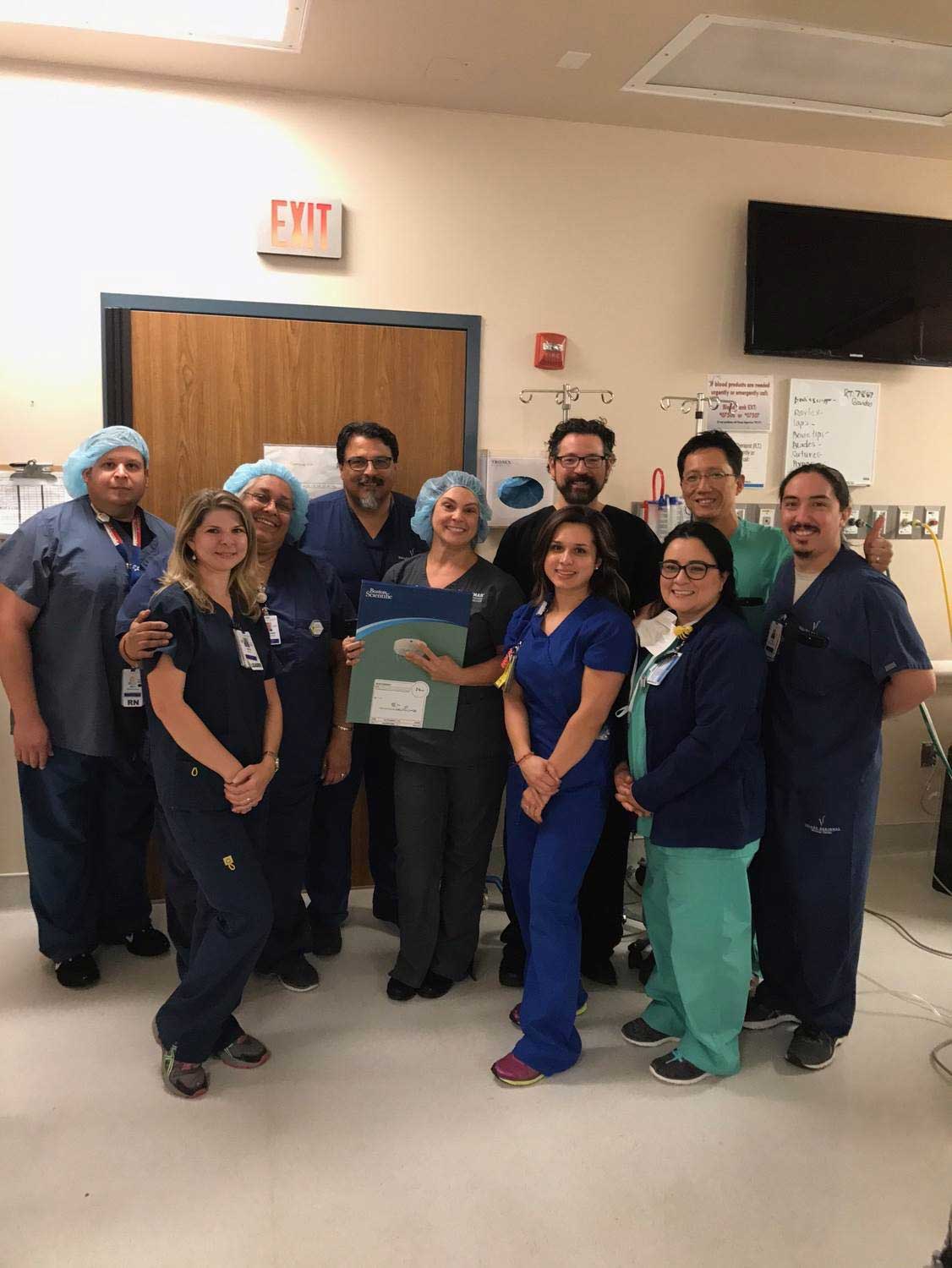
James Strickland, MD, and the first WATCHMAN Implant Recipient in South Texas, Mary Lou Homaizad
Brownsville, TX, September 7, 2017 – Valley Regional Medical Center is the first and only hospital south of San Antonio to offer patients with non-valvular atrial fibrillation an alternative to long-term warfarin medication with the recently Medicare approved WATCHMAN™ Left Atrial Appendage Closure (LAAC) Implant.
James Strickland, MD, a board certified Cardiac Electrophysiologist, implanted the Rio Grande Valley’s first WATCHMAN device in Mrs. Mary Lou (Maria) Homaizad, a patient with non-valvular atrial fibrillation. “For patients like Mrs. Homaizad, the WATCHMAN offers a safe and effective alternative to lifelong blood thinners to reduce their risk of atrial fibrillation-related stroke,” said Dr. Strickland.
“I am so happy Dr. Strickland is here at Valley Regional and that he was able to see me right here in Brownsville. Dr. Strickland and the entire team at Valley Regional has been so good to me. Thank you,” said Mrs. Homaizad.
The WATCHMAN Implant is designed to close off an area of the heart called the left atrial appendage (LAA) in order to keep harmful blood clots from entering the blood stream and potentially causing a stroke. By closing off the LAA, the risk of stroke is significantly reduced and, within weeks, patients are able to stop taking warfarin.
Mrs. Homaizad is one of an estimated five million Americans who are affected by atrial fibrillation - an irregular heartbeat. People with atrial fibrillation have a five times greater risk of stroke. Atrial fibrillation can cause clots to form in the LAA. For patients with non-valvular atrial fibrillation, this potential clot formation increases one’s risk of having a stroke.
Appropriate candidates for the WATCHMAN may have one or more of the following:
- A history of significant bleeding while taking therapeutic anticoagulation therapy
- Prior inability to maintain a stable warfarin level AND unavailability of an approved alternative anticoagulation agent
- A medical condition, occupation, or lifestyle which places the patient at a higher risk for major bleeding.
 Implanting the WATCHMAN Device is a one-time, minimally invasive procedure that usually lasts about an hour. Following the procedure, patients are monitored overnight and typically discharged home the following day.
Implanting the WATCHMAN Device is a one-time, minimally invasive procedure that usually lasts about an hour. Following the procedure, patients are monitored overnight and typically discharged home the following day.
Valley Regional Medical Center will host a Community Doc Talk with Dr. Strickland about Atrial Fibrillation and the WATCHMAN on Thursday, September 28, 2017.
For more information on the Atrial Fibrillation Program at Valley Regional Medical Center or the WATCHMAN Implant, please contact Mariana Tumlinson, Director of Community and Public Relations, at (956) 350-7745.
About Valley Regional Medical Center
Valley Regional Medical Center is located at the corner of Expressway 77 and Alton Gloor Boulevard in Brownsville. With physicians representing more than 25 specialties, Valley Regional Medical Center is a leader in a vast array of high quality programs, including surgical robotics, advanced diagnostic imaging, interventional cardiac catheterization, open-heart surgery, bariatric surgery, laparoscopic and endoscopic surgeries, neurosurgery, orthopedic surgery, women’s services, pediatric services and neonatal intensive care. Valley Regional Medical Center is a nationally accredited Advanced Primary Stroke Center and the Emergency Department is designated as an Advanced Level III Trauma Center treating a wide range of emergent needs 24 hours a day. For more information on Valley Regional Medical Center’s programs and services, visit our website at Valley Regional Medical Center.
About HCA Gulf Coast Division
HCA Healthcare Gulf Coast Division is a comprehensive network of hospitals, outpatient surgery centers, emergency centers and diagnostic imaging facilities in greater Houston, Corpus Christi and South Texas. Facilities in the Gulf Coast Division include: 18 hospitals, nine ambulatory surgical centers, 10 freestanding emergency centers, and a regional transfer center that provides one phone call access and support for patient transfers into and out of the HCA Gulf Coast Division Affiliated Hospitals as well as access to ground and air transportation within a 150- mile radius. For more information, visit HCA Gulf Coast.